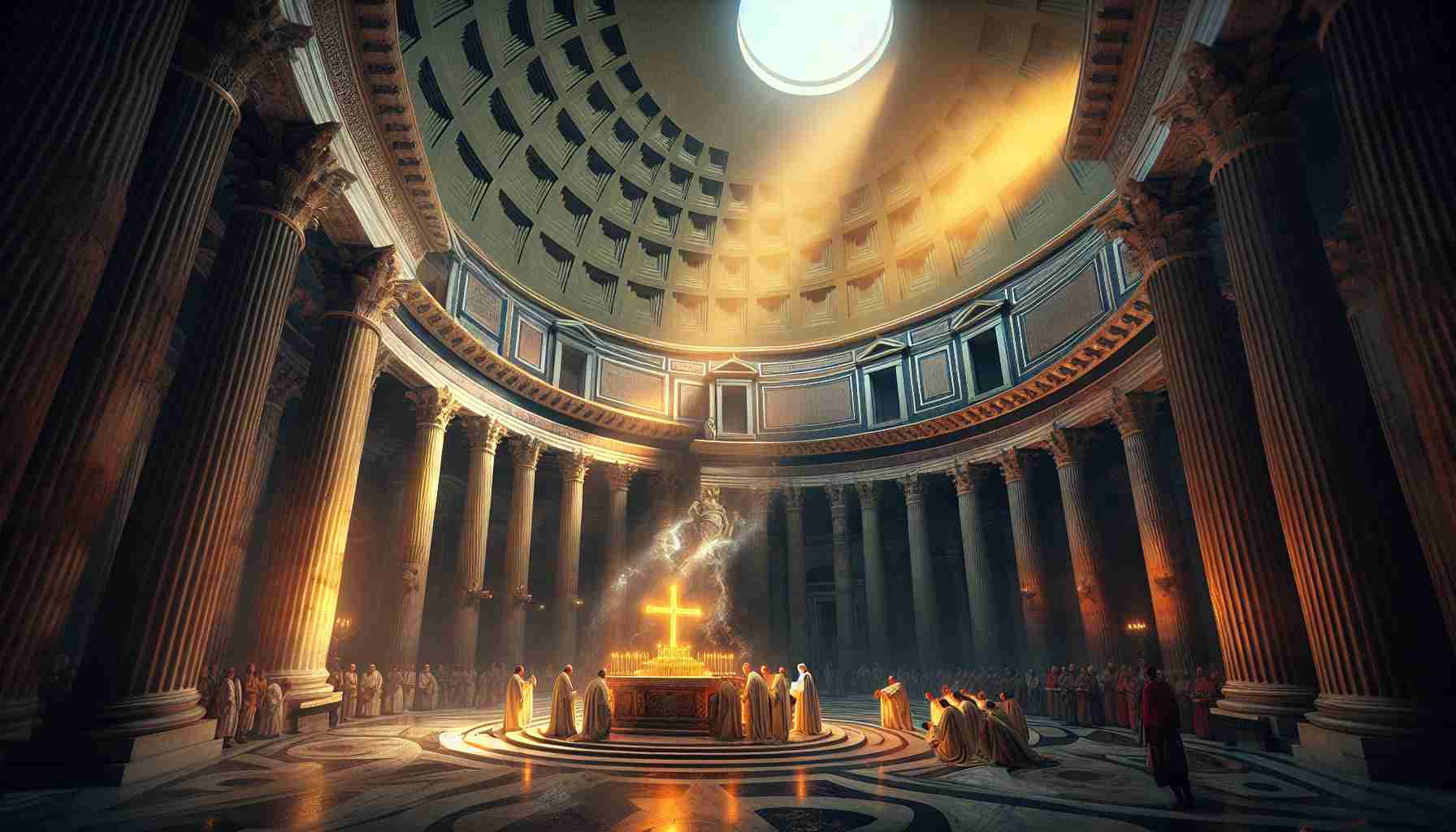

Rome, May 13th, 609 A.D.
The sun cast molten light upon the ancient dome of the Pantheon, its oculus blazing like a staring eye of heaven. Dust swirled through the shaft of light, twisting over marbled columns once steeped in incense for gods long silent. The air carried no oracles now—only the echo of sandals scuffing stone, the creak of wooden doors trembling on ancient hinges, and the scent of oil, frankincense, and consecration.
Behind a veil of ash-colored smoke, Pope Boniface IV moved slowly toward the altar. His robes, ivory and crimson, caught the sun like a banner; his shoulders bowed not beneath age, but burden. Over a hundred cartloads of bones—martyrs from the catacombs—had been brought in solemn procession, their remains interred beneath the mighty vault. Witnesses of another empire. Blood for stone, faith for fire.
Once, this temple had breathed the names of Venus, Mars, Vulcan—every deity in Rome’s pantheon lifted in prayer and sacrifice here. It was Hadrian, they said, who rebuilt it after fire, erecting the coffered dome that still defied time and tremor. Beyond its portico, emperors once passed in triumph. Within, they bent the world toward the favor of gods carved in marble.
But the gods had crumbled.
Now there was silence. No rustle of togas or mutter of augurs, no sacrificial smoke curling toward Jupiter’s throne. The only sound was the low Latin chant rising like a tide, trembling through the nave where no Christian once dared set foot.
A bishop placed a small golden cross on the altar, and with it, the room changed. The symbols of Christ overtook the ancient dome. Heaven opened in stone. What had been Roman was now redeemed.
“I saw a new heaven and a new earth…” The voice of the Pope rang clear against the dome’s perfect acoustics, drawn from the closing vision of Revelation. “Behold, He who sits upon the throne says, 'I am making all things new.'”
Women wept. Men dropped to their knees, making the sign of the cross with trembling fingers. Soldiers in rusted lamellar armor, their brows still creased by the wars of the time, now bowed before a greater King.
Beneath the altar, hidden beneath slabs of porphyry, the relics of the martyrs lay wrapped in silk. Damasus. Cecilia. Sixtus the Second. Their names not carved on monuments but remembered in whispers and tears, pressed into the soil of Rome when their bodies met dogs and flames for the crime of believing Christ Lord.
Now they rested in a temple once hostile to their faith.
Some called it desecration—an emperor’s marvel turned from the gods of Rome. Others called it divine justice. Either way, there was no denying the symbolism chiseled into the act: the greatest monument of a fallen empire now consecrated to a faith it had once tried to extinguish.
Historians centuries later would speculate. Some claimed the Pantheon had never truly been pagan, a mystery its architect never explained. The inscription still hailed “Marcus Agrippa, son of Lucius”, though he did not build the dome. Others mused that the perfect sphere of the building was meant to echo the vault of the heavens, the oculus a gateway between gods and men.
But now, the gateway belonged to the One who shattered veils and shook tombs open.
Candles flickered against the colossal Corinthian columns. Wind whispered through open doors, sweeping petals of white roses across the floor. A boy in rags lingered near a pillar, watching, breath caught in silent awe. His father had warned him against entering Roman temples. Especially this one. Yet here, he saw no idols. Only a gentle mother carved in stone—Mary, Queen of Martyrs—holding heaven’s child in her arms.
Outside, the city teetered on chaos still. The empire had crumbled. Barbarians ruled parts of the parchment-map Rome once claimed. Starvation lingered behind market stalls. Yet inside these walls, something eternal had kindled. Not power. Not conquest. But redemption.
The bells rang out above, where pigeons startled from ledges took flight into the Roman sky.
Santa Maria ad Martyres, they called it now. A church from a tomb of demons. A house of God reborn from stone shaped in the image of man’s glory.
And so the Pantheon endured—not as a museum, not as a ruin, but as witness. Blood may forge empires, but grace reshapes them. What men built for their gods, God seized for Himself—not in violence, but mercy.
As the final prayers dissolved into incense, the Pope’s voice wavered again.
“He will wipe every tear from their eyes.”
A murmur swept the crowd like wind in leaves.
There would still be tears, still be war and ruin. But here, within this dome pierced by light, heaven had declared its claim.
The past was not erased.
It was redeemed.